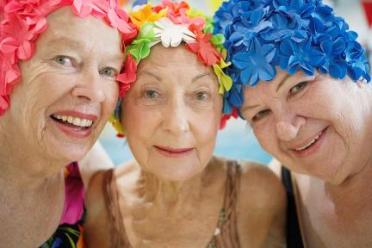Talk with your Aging Parents About Senior Citizens Swimming to
Develop Aging Fitness
Senior citizens swimming has been studied by researchers, and has amazing benefits for senior health and benefits.
"Our study combined aqua aerobics -- walking and dancing in the water -- with actual strength training in the water. The participants lifted weights while they were in the water.
On average, aqua exercise participants increased their strength by 27% in the quadriceps, 40% in the hamstrings, and about 10% in the upper body region.
This increase in strength is attributed to the resistance that can be more easily experienced in water than on land."
The American College of Sports Medicine and American Heart Association published
guidelines for physical activity in older adults. Here is a summary of their recommendations --
"To promote and maintain health, older adults need moderate-intensity aerobic physical activity for a minimum of 30 minutes five days each week or vigorous intensity aerobic activity for a minimum of 20 minutes three days each week. (Moderate intensity is when you feel "warm and slightly out of breath," and vigorous is when you feel "out of breath and sweaty.")" Senior citizen swimming can easily meet these requirements.
Water Aerobics
Another alternative for exercising in water is to try water aerobics. Many health and fitness centers offer water aerobics classes for senior citizens.
Watch and practice these video routines:
Best Water Exercises - Water Routines 1
Water Aerobic Exercise - Water Routines 2
Water Aerobic Exercises - Water Routines 3
These water courses enhance flexibility, and cardiovascular and muscular endurance. Participants have a choice of a group “aqua-aerobics” activity in the pool or individual swimming in the dive tank. There is less strain on joints and ligaments so less chance for injury with this type of activity. In aqua-aerobics an instructor demonstrates the various exercises of arms, legs and core body which are often done to music. These courses usually meet several times per week.
For those with bone, muscle, or joint troubles, the warmth, buoyancy, and resistance of the water challenges the body while easing strain on problematic area. The benefits can include a decrease in pain, improved daily function, and improved perceived quality of life.

Water Walking
Water walking is easy on the joints. Water buoyancy supports the body’s weight, so there is less stress on joints. Water provides 12 times the resistance of air, so as you walk, you’re really strengthening and building muscle. You do not bear weight while swimming and walking, however, so you’ll still need to add some bone-building workouts to your routine.
You can walk in either the shallow end of the pool or the deep end, using a flotation belt. The deeper the water, the more strenuous your workout. And if you fall in love with senior citizens swimming and walking, you can keep going in cooler months – just switch to an indoor heated pool.
What you need: For deep-water walking, a flotation belt keeps you upright and floating at about shoulder height.
How it works: You’ll stand about waist- to chest-deep in water, unless you’re deep-water walking. “You walk through the water the same way you would on the ground,” says Jones. Try walking backward and sideways to tone other muscles.
Try it: Stand upright, with shoulders back, chest lifted and arms bent slightly at your sides. Slowly stride forward, placing your whole foot on the bottom of the pool (instead of just your tiptoes), with your heel coming down first, then the ball of your foot. Avoid straining your back by keeping your core (stomach and back) muscles engaged as you walk.
Add intensity: Lifting your knees higher helps boost your workout. You also can do interval training – pumping arms and legs faster for a brief period, then returning to your normal pace, repeating the process several times.
Stationary Swimming
These new fitness equipment systems are sometimes referred to as a "treadmill for swimmers". They can be installed in places where there is not room for a traditional pool. They contain an adjustable current that allows users to swim or exercise in place. The current is broad, deep and suitable to every swimming ability and fitness need. You can also set the temperature precisely, based on preferences and needs.Several companies produce these with varying features and price points.
AEROBIC EXERCISES
Senior citizens swimming
Walking -
Exercises for Senior Citizens
Senior Cycling
Senior Exercise Routines: Warm-up, Balance, Upper and Lower
Senior Citizens Swimming to Talk Early Talk Often With Aging Parents Home Page